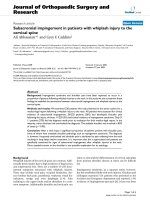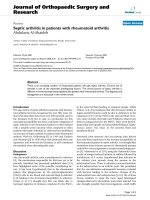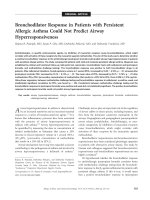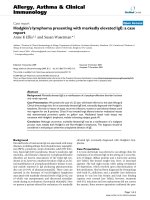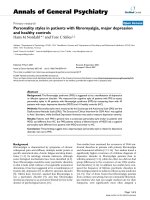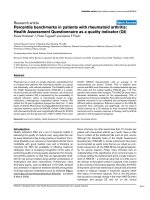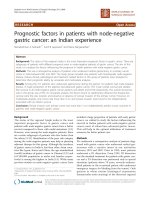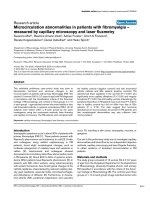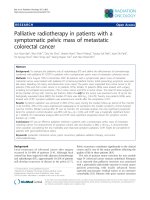Báo cáo y học: "Serum IL-15 in patients with early systemic sclerosis: a potential novel marker of lung disease" potx
Bạn đang xem bản rút gọn của tài liệu. Xem và tải ngay bản đầy đủ của tài liệu tại đây (259.01 KB, 9 trang )
Open Access
Available online />Page 1 of 9
(page number not for citation purposes)
Vol 9 No 5
Research article
Serum IL-15 in patients with early systemic sclerosis: a potential
novel marker of lung disease
Dirk M Wuttge, Marie Wildt, Pierre Geborek, Frank A Wollheim, Agneta Scheja and Anita Åkesson
Department of Rheumatology, Lund University Hospital, S-221 85 Lund, Sweden
Corresponding author: Dirk M Wuttge,
Received: 19 Jun 2007 Revisions requested: 27 Jul 2007 Revisions received: 9 Aug 2007 Accepted: 4 Sep 2007 Published: 4 Sep 2007
Arthritis Research & Therapy 2007, 9:R85 (doi:10.1186/ar2284)
This article is online at: />© 2007 Wuttge et al., licensee BioMed Central Ltd.
This is an Open Access article distributed under the terms of the Creative Commons Attribution License ( />2.0), which permits unrestricted use, distribution, and reproduction in any medium, provided the original work is properly cited.
Abstract
The pathogenesis of systemic sclerosis (SSc) is characterized
by autoimmunity, vasculopathy and fibrosis. IL-15 is a pleiotropic
cytokine that has impact on immune, vascular and connective
tissue cells. We therefore investigated IL-15 in the circulation of
patients with early SSc and explored possible associations of
serum IL-15 with vasculopathy and fibrosis. Serum levels of IL-
15 were analysed in 63 consecutive patients with SSc of
disease duration less than 4 years and without disease-
modifying treatment. Thirty-three age-matched healthy control
individuals were enrolled. Serum IL-15 levels were increased in
the sera of SSc patients compared with that of healthy control
individuals (P < 0.01). Serum IL-15 levels correlated with
impaired lung function, assessed both by the vital capacity (P <
0.05) and by the carbon monoxide diffusion capacity (P < 0.05).
The association between IL-15 and the vital capacity remained
after multiple linear regression analysis. Patients with
intermediate serum IL-15 levels had a higher prevalence of
increased systolic pulmonary pressure compared with patients
with either low or high serum IL-15 levels (P < 0.05). Moreover,
increased serum IL-15 levels were associated with a reduced
nailfold capillary density in multivariable logistic regression
analysis (P < 0.01). Serum IL-15 levels also correlated inversely
with the systolic blood pressure (P < 0.01). We conclude that
IL-15 is associated with fibrotic as well as vascular lung disease
and vasculopathy in early SSc. IL-15 may contribute to the
pathogenesis of SSc. IL-15 could also be a candidate biomarker
for pulmonary involvement and a target for therapy in SSc.
Introduction
IL-15 is a cytokine of 14 to 15 kDa that belongs to the 4-a-helix
bundle cytokine family, which also includes cytokines such as
IL-2, IL-4 and IL-21. IL-15 signals through its specific IL-15
receptor α-chain that binds IL-15 with high affinity, and
through the common IL-2 receptor γ-chain [1]. Recent studies
have clarified that IL-15 is a survival and growth factor for T
lymphocytes and B lymphocytes, for natural killer cells, for
eosinophils and for mast cells [1-4]. IL-15 has emerged as an
important molecule involved in autoimmunity and transplanta-
tion [5,6], and is considered a possible target for therapy in
rheumatoid arthritis [7].
IL-15 mRNA is expressed in many tissues throughout the
body, suggesting additional biologic functions outside the
immune system. We have previously shown that IL-15 is
expressed both by endothelial cells and by vascular smooth
muscle cells in normal vessels [8]. IL-15 is also expressed in
heart and skeletal muscle cells, in fibroblasts, in adipocytes, in
epithelial cells as well as in keratinocytes [1,8]. IL-15 is
expressed in the skin of TSK mice [9].
Several IL-15 signalling pathways are also implied in the puta-
tive pathogenesis of systemic sclerosis (SSc). IL-15 may con-
tribute to autoimmunity via its effects on the activation and
survival of T lymphocytes and B lymphocytes [2,3]. IL-15 may
enhance perivascular infiltrates [10] and may induce CD44-
mediated endothelial transmigration of lymphocytes [11]. IL-
15 has also been shown to induce A1 and A2 arteriole con-
traction in a rat model [12]. A similar mechanism could lead to
Raynaud's phenomena and other features of vasculopathy in
SSc. In addition, IL-15 could contribute to the development of
β
est
= regression coefficient; DLCO = diffusing capacity for carbon monoxide; ELISA = enzyme-linked immunosorbent assay; IL = interleukin; p% =
population percentage; r = partial correlation coefficient; r
s
= Spearman’s correlation coefficient; SSc = systemic sclerosis; TNF = tumour necrosis
factor; VC = vital capacity.
Arthritis Research & Therapy Vol 9 No 5 Wuttge et al.
Page 2 of 9
(page number not for citation purposes)
fibrosis by preventing apoptosis of collagen-producing myofi-
broblasts. Such a mechanism is supported by the observation
that IL-15 can prevent TNFα-induced apoptosis of synovial
fibroblasts in rheumatoid arthritis [13]. IL-15 has been shown
to aggravate graft versus host disease [6], a disease with skin
changes similar to SSc [14].
For all these reasons we considered it of interest to explore the
occurrence of IL-15 in the circulation of patients with early
SSc [15], with special regard to the possible association of IL-
15 with vasculopathy and fibrosis.
Materials and methods
Patients and control individuals
From 1 January 1990 to 31 June 2005 serum samples were
collected from consecutive patients, when they first presented
to our unit, who fulfilled the inclusion criteria of: a definitive
diagnosis of SSc according to the American College of Rheu-
matology [16]; a disease duration less than 4 years from the
onset of skin involvement; and no previous treatment with any
of the following drugs: azathioprine, chlorambucil, colchicine,
cyclophosphamide, cyclosporine, D-penicillamine, methotrex-
ate or mycophenolate mofetil.
Sixty-three patients (51 women, 12 men) with a median age of
54 years (range 23 to 78 years) and a median disease dura-
tion of 18 months (range 3 to 42 months) met these criteria.
Forty-five patients (38 women, seven men) had limited cutane-
ous SSc, and 18 patients (13 women, five men) had proximal
skin involvement and fulfilled the criteria for diffuse cutaneous
SSc [17]. Fourteen patients were on treatment with a median
(25th and 75th percentiles) of 10 mg (5 to 20 mg) pred-
nisolone daily. Medications that may have influenced the systo-
lic blood pressure at the time of evaluation consisted of
calcium channel blockers (n = 26), angiotensin-converting
enzyme inhibitors (n = 2), diuretics (n = 3), β-blockers (n = 2)
or a combination thereof (n = 4). Smoking summarized all cur-
rent smokers (n = 14) or previous smokers (n = 6), whereas
nonsmokers included the remaining patients that had never
smoked (n = 43). Thirty-three age-matched healthy control
individuals were also enrolled. Informed consent was obtained
from all participants.
Clinical assessment
All clinical and laboratory data reported in this study were
obtained within 1 week of blood sampling. The modified Rod-
nan skin score was evaluated by standardized palpation of the
skin at 17 locations on the body and grading the skin thickness
on a scale from 0 to 3, resulting in a maximum skin score of 51
points [18]. Nailfold capillaries were analysed quantitatively by
direct microscopy counts of capillaries per millimetre on at
least two fingers [19]. A capillary density below the second
standard deviation of a normal population of 80 healthy individ-
uals (<5.8 loops/mm) was regarded as pathologically reduced
(A. Scheja, personal communication).
Oesophageal involvement was defined as distal hypomotility
on cine radiography. Radiological lung involvement was
defined as basal interstitial fibrosis on a plain chest X-ray scan
or on high-resolution computer tomography. Lung function
tests included assessment of the vital capacity (VC) by dry
spirometry and of the diffusing capacity for carbon monoxide
(DLCO) by the single-breath test. All values are depicted as
the population percentage (p%). DLCO values less than 75
p% were regarded as reduced.
Cardiac involvement was assessed by radiological examina-
tion of the chest, by 12-lead electrocardiography and by Dop-
pler cardiography, and was defined as pericarditis, an
abnormal electrocardiography or cardiomegaly. Systolic pul-
monary artery pressures of 40 mmHg and above determined
by Doppler cardiography were regarded as pathologically
increased.
Muscle involvement was defined as proximal muscle weak-
ness or serum creatinine kinase levels elevated three times or
more above the upper normal limit (3.3 μkat/l). Joint involve-
ment was defined as palpable synovitis.
Renal involvement was defined as a decreased glomerular fil-
tration rate <70 p%, either assessed by
51
Cr-ethylenediamine
tetraacetic acid and iohexol clearance [20] or calculated from
serum cystatin C levels [21].
Antinuclear antibodies were analysed by an indirect immun-
ofluorescence technique using the human Hep-2 cell line as
the substrate [22]. Inflammatory activity was defined as either
an increased erythrocyte sedimentation rate (≥15 and ≥22
mm/hour for men below and above age 50 years, respectively;
≥24 and ≥32 mm/hour for women below and above age 50
years, respectively), an increased C-reactive protein level (≥3
mg/l), or an increased orosomucoid level (>1.17 g/l).
Measurement of IL-15
IL-15 was assayed with a commercial human IL-15 ELISA
(R&D Systems, Minneapolis, MN, USA), following the manu-
facturer's instructions. Each serum sample was tested in dupli-
cate. A linear detection range of the ELISA above 0.1 pg/ml
has previously been reported [23]. The detection threshold
was set above the blank value.
Statistical analyses
Data were analysed with STATISTICA version 6 (StatSoft,
Tulsa, OK, USA) and are depicted as the median (25th and
75th percentiles). The Kruskal–Wallis test was used for multi-
ple group comparison, before the Mann–Whitney test was
used for comparison between two groups. The chi-square test
for 2 × 3 tables was used when applicable. Frequencies
between groups were calculated by Fisher's exact test. All var-
iables and groups as well as residuals in multiple linear regres-
sion analyses were analysed for a normal distribution and were
Available online />Page 3 of 9
(page number not for citation purposes)
tested by the Shapiro–Wilk test. W values >0.93 were
accepted as normally distributed. Spearman's (r
s
) and partial
correlations as well as multiple linear regression analyses were
used to estimate correlations.
Data are expressed as the partial correlation coefficient (r), the
regression coefficient (β
est
), the 95% confidence interval and
as the coefficient of determination. For continuous variables,
the standardized β
est
value and the 95% confidence interval is
depicted. Results of multivariable logistic regression are
depicted as the odds ratio and the 95% confidence interval.
Probability P values (two-sided) were considered significant
when <0.05.
Results
Serum IL-15 levels
Increased serum IL-15 levels were observed in SSc patients
(0.63 (0.47 to 0.88) pg/ml) compared with the healthy individ-
uals (0 (0 to 0.46) pg/ml) (Figure 1). This applied to IL-15 lev-
els in patients with limited cutaneous SSc (0.63 (0.45 to 0.83)
pg/ml) and diffuse cutaneous SSc (0.72 (0.47 to 1.03) pg/ml)
compared with control individuals, but the IL-15 levels did not
differ between limited cutaneous SSc and diffuse cutaneous
SSc.
Three outliers were identified in the SSc patient group. Two of
these outliers were excluded from further analysis since both
were derived from patients in renal crisis, one of which was
already undergoing haemodialysis, and the reduced renal
function might impede IL-15 elimination. The third outlier, how-
ever, had no identifiable confounding factors and was there-
fore included in the analysis.
Serum IL-15 levels of the 61 studied patients fulfilled the crite-
ria for a normal distribution. Fourteen out of 33 control individ-
uals had detectable levels of IL-15. These individuals did not
take any medications; neither did they have any accompanying
disease or did they differ in age from the other control
individuals.
Low, intermediate and high serum IL-15 levels describe
three subsets of SSc patients
Low, intermediate and high serum IL-15 levels depict three
subsets of SSc patients regarding the skin score, the VC, the
DLCO and the systolic pulmonary arterial pressure. Table 1
presents the findings of patients with low, intermediate and
high levels of IL-15.
The 75th percentile of all SSc patients (0.88 pg/ml) was cho-
sen as the cut-off value for high serum levels of IL-15 because
serum IL-15 levels in the control individuals were not normally
distributed in accordance with other studies [24] (Figure 1). In
the group with high serum IL-15 levels, diffuse cutaneous SSc
was twice as prevalent as limited cutaneous SSc. Among
patients with low or intermediate serum IL-15 levels, limited
cutaneous SSc predominated. The VC was significantly lower
among patients with high IL-15 levels (P < 0.05).
We tested the possibility that a lower dividing point between
low IL-15 levels and high IL-15 levels could change the char-
acteristics of our patient groups. The median value of the SSc
patients (0.63 pg/ml) was chosen as alternative cut-off level.
Twenty-eight patients with serum IL-15 levels ≥0.64 pg/ml
were compared with 33 patients with serum IL-15 levels
<0.64 pg/ml. Lower DLCO levels (P < 0.01) and a higher
prevalence of reduced finger capillary density (P < 0.05) were
found in patients with serum IL-15 levels ≥0.64 pg/ml. The skin
score, the SSc type or the VC showed no difference. Group-
ing the patients into those with low (<0.64 pg/ml), intermedi-
ate (0.64 to 0.88 pg/ml) and high (>0.88 mg/ml) serum IL-15
levels, however, showed that the group with high serum IL-15
levels had both low VC and low DLCO (Table 1). The interme-
diate group had a tendency to lower DLCO compared with the
group with low serum IL-15 levels (Figure 2), although the two
groups had similar skin scores or VC levels. The intermediated
group also had a higher prevalence of patients with reduced
DLCO (<75 p%) compared with the group with low serum IL-
15 levels (53% versus 21%, P < 0.05). In addition, the VC/
DLCO ratio tended to be higher in the intermediate serum
Figure 1
Serum concentrations of IL-15 in patients with systemic sclerosis increase compared with healthy control individualsSerum concentrations of IL-15 in patients with systemic sclerosis
increase compared with healthy control individuals. Striped circles,
patients on cortisone treatment; filled circles, two patients with renal
crises; horizontal bars, median (25th and 75th percentiles) in each
group; dashed line, cut-off value for increased serum levels of IL-15
(75th percentile of all systemic sclerosis (SSc)); fine dotted line, detec-
tion level. dcSSc, diffuse cutaneous systemic sclerosis; lcSSc, limited
cutaneous systemic sclerosis; n.s., not significant.
Arthritis Research & Therapy Vol 9 No 5 Wuttge et al.
Page 4 of 9
(page number not for citation purposes)
level group, indicating predominating pulmonary vascular dis-
ease. Pulmonary hypertension (defined as systolic pulmonary
pressure ≥40 mmHg) was found in four out of eleven patients
(36%) in the intermediate IL-15 group, compared with one out
of 31 patients (3%; P < 0.05) in the low IL-15 level group and
zero out of 13 patients (0%; P < 0.05) in the high IL-15 group.
Association between IL-15 and lung function
IL-15 correlated negatively with the VC (r
s
= -0.31, P < 0.05).
This correlation became even more significant after statistical
consideration of the presence of cortisone treatment by partial
correlation (r = -0.42, P < 0.001). Multiple linear regression
analysis of laboratory variables that may influence the VC
Table 1
Characteristics of systemic sclerosis patients with low, intermediate and high serum IL-15 levels
Characteristic Low IL-15 level,
<0.64 pg/ml
(n = 33)
Intermediate IL-15
level, 0.64–0.88
pg/ml (n = 15)
High IL-15 level,
>0.88 pg/ml
(n = 13)
Female/male 29/4 (88/12) 11/4 (73/27) 10/3 (77/23)
Age at onset (years) 52 (45–57) 48 (45–54) 57 (53–61)
Disease duration (months) 19 (13–28) 16 (11–25) 11 (8–21)
Clinical features
Skin score (points) 9 (4–14) 11 (4–17) 15 (8–21)
Diffuse cutaneous systemic sclerosis/limited
cutaneous systemic sclerosis
8/25 (24/76) 3/12 (20/80) 6/7 (46/54)
Pitting scars or ulcer 9 (27) 6 (40) 3 (23)
Telangiectasis 9 (27) 6 (40) 1 (8)
Calcinosis 6 (18) 5 (33) 5 (38)
Organ involvement
Oesophagus 20 (61) 11 (73) 10 (77)
Lung (radiological) 7 (21) 2 (13) 4 (31)
Heart 5 (15) 4 (27) 4 (31)
Kidney 1(3)1(7)0(0)
Muscle 1(3)2(13)1(8)
Joint 5 (15) 1 (7) 0 (0)
Lung function tests
Vital capacity (p%) 94 (85–
103)
94 (84–
105)
75 (66–
89)*
Diffusing capacity for carbon monoxide (p%) 84 (77–97) 71 (60–
87)
†
70 (62–
81)
‡
Serological findings
Antinuclear antibodies 21 (64) 14 (93) 11 (85)
Anti-scleroderma-70 antibodies 6 (18) 4 (27) 2 (15)
Anticentromer antibodies 10 (30) 2 (13) 2 (15)
Laboratory findings
Erythrocyte sedimentation rate (mm/hour) 17 (10–27) 12 (8–22) 12 (6–18)
C-reactive protein (mg/l) 0 (0–6) 0 (0–8) 1.6 (0–8.1)
Orosomucoid (g/l) 0.8 (0.68–
0.91)
0.86 (0.77–
0.96)
0.85 (0.80–
1.11)
IgG (g/l) 10.9 (9.5–
14.6)
9.5 (7.6–
12.2)
12.6 (9.6–
15.1)
Data presented as the median (25th and 75th percentiles) or as n (%). Kruskal–Wallis analysis showed P < 0.05 for the vital capacity and
diffusing capacity for carbon monoxide. *P < 0.05 for high IL-15 serum level versus low and intermediate IL-15 serum levels;
‡
P < 0.05 for high IL-
15 serum level versus low IL-15 serum level;
†
P = 0.057 for intermediate IL-15 serum level versus low IL-15 serum level.
Available online />Page 5 of 9
(page number not for citation purposes)
showed that only IL-15 correlated inversely with the VC,
whereas the presence of anticentromer antibodies was asso-
ciated with high VC (Table 2). All associations remained sig-
nificant after adjustment for multiple correlations and for
smoking.
IL-15 also correlated inversely to the DLCO (r
s
= -0.33, P <
0.05), and the correlation remained after adjustment for
cortisone (r = -0.32, P < 0.05). Applying multiple linear regres-
sion analysis of IL-15 and the DLCO including autoantibodies
and inflammatory parameters, the inverse relation did not
remain significant after adjustment for multiple correlations.
When the two patients with renal crisis were included in the
analyses, however, the multiple linear regression analyses of
IL-15 against both the VC and the DLCO became strong (r =
-0.54, P < 0.001 for IL-15 versus VC; r = -0.46, P < 0.001 for
IL-15 versus DLCO).
Relation of IL-15 to nailfold capillary density
Forty-two out of 54 examined patients showed a reduced nail-
fold capillary density and had significantly increased serum IL-
15 levels (0.72 (0.49 to 0.90) pg/ml) compared with the
remaining 12 patients (0.47 (0.27 to 0.61) pg/ml) (P = 0.010).
Figure 2
Low, intermediate and high serum IL-15 levels describe three groups of systemic sclerosis patientsLow, intermediate and high serum IL-15 levels describe three groups of systemic sclerosis patients. Low, intermediate and high serum IL-15 levels
depict three groups of systemic sclerosis patients with different skin score (white bars), different vital capacity (VC; grey bars) and different diffusing
capacity for carbon monoxide (DLCO; black bars). Bars depict the median (25th and 75th percentile), and lines depict the 10th and 90th percen-
tiles. Kruskal–Wallis analysis showed P < 0.05 for VC and DLCO with P = not significant for skin score. *P < 0.05 for VC of high IL-15 serum level
versus low and intermediate IL-15 serum levels. *P < 0.05 for DLCO of high IL-15 serum level versus low IL-15 serum level. P = 0.057 for DLCO
intermediate IL-15 serum level versus low IL-15 serum level. p%, population percentage.
Table 2
Association of vital capacity with serum markers by multiple linear regression analysis
β
est
(95% confidence interval) rP
IL-15 -0.36 (-0.57 to -0.14) -0.40 0.002
Inflammatory activity 1.65 (-6.45 to 9.75) 0.05 0.691
Anticentromer antibodies 19.49 (9.72 to 29.27) 0.46 <0.001
Anti-scleroderma-70 antibodies -0.60 (-10.49 to 9.30) -0.02 0.605
Coefficient of determination = 37%. Inflammatory activity describes an increased erythrocyte sedimentation rate, increased C-reactive protein or
increased orosomucoid either alone or in combination.
Arthritis Research & Therapy Vol 9 No 5 Wuttge et al.
Page 6 of 9
(page number not for citation purposes)
Serum IL-15 levels were identified as an important variable for
the occurrence of reduced nailfold capillary density using mul-
tivariable logistic regression analysis (Figure 3). This correla-
tion remained significant after adjustment for multiple
correlations.
Association between IL-15 and blood pressure
IL-15 correlated inversely with the systolic blood pressure by
multiple linear regression analysis including variables that may
influence the systolic blood pressure (Table 3). Age and the
body mass index showed the expected positive correlation
with systolic blood pressure. These data remained significant
after adjustment for multiple correlations.
Discussion
Interstitial lung disease and pulmonary hypertension are cur-
rently the major causes of death in SSc [25]. Early diagnosis
is crucial for initiation of treatment for SSc patients. In the
present study, serum IL-15 levels were strongly negatively cor-
related with the VC. This liaison remained even after taking into
account the presence of inflammatory markers or SSc-related
antibodies that may influence the VC. This finding suggests a
profibrotic activity of IL-15. In contrast, anticentromer antibod-
ies correlated positively with the VC, which is in accordance
with previous data showing that patients with anticentromer
antibodies are relatively protected from pulmonary fibrosis
[26]. Increased serum IL-15 levels have previously been found
in sera of patients with various rheumatic diseases and inter-
stitial pneumonia, including seven patients with SSc [23].
Fibrosis leading to restrictive interstitial lung disease and
increased skin thickness is the hallmark of SSc. IL-15 may
enhance perivascular inflammatory infiltrates by activation of
endothelial cells to promote CD44-mediated extravasation of
inflammatory cells [11]. Perivascular infiltrates are commonly
seen early in SSc and are considered important for the initia-
tion of the fibrotic response [10]. IL-15 has also been shown
to prevent TNFα-mediated apoptosis of fibroblasts [13]. IL-15
may therefore promote myofibroblast survival and may
increase production of the extracellular matrix.
Isolated reduction of the DLCO and an increased VC/DLCO
ratio is highly suggestive for pulmonary hypertension primarily
of vascular origin [26]. An intriguing observation was that the
Figure 3
Relation between different serum markers and the occurrence of a reduced nailfold capillary densityRelation between different serum markers and the occurrence of a reduced nailfold capillary density. Serum IL-15 correlated with an increased risk
of reduced nailfold capillary density when compared with systemic-sclerosis-related antibodies and markers for inflammatory activity. Inflammatory
activity describes an increased erythrocyte sedimentation rate, increased C-reactive protein or increased orosomucoid either alone or in combina-
tion. ACA, anticentromer antibody; 95% CI, 95% confidence interval; n.s., not significant; Scl-70, anti-scleroderma-70 antibody.
Odds Ratio (95% CI)
4.13 (1.40-12.2)
0.50 (0.10-2.49)
9.91 (0.68-143)
3.82 (0.47-30.9)
<0.01
n.s.
n.s.
n.s.
P - value
Odds Ratio for reduced nailfold capillary density
IL-15
Inflammatory
activity
ACA
Scl-70
0.1 1.0 10 100
(n = 54)
Available online />Page 7 of 9
(page number not for citation purposes)
group of patients with intermediate serum IL-15 levels differed
from the patients with low serum IL-15 levels by having a
higher prevalence of reduced DLCO in concert with an
unchanged skin score and VC as well as a higher VC/DLCO
ratio, suggesting isolated pulmonary vascular involvement. The
patients also had a high prevalence of increased systolic pul-
monary pressure. Intermediate serum IL-15 levels therefore
appeared to reflect pulmonary vascular involvement whereas
high levels of serum IL-15 were associated with restrictive
interstitial lung disease. Further studies are needed to confirm
and explain the finding that only the group with an intermediate
IL-15 serum level was associated with pulmonary hyperten-
sion whereas the group with high serum IL-15 levels did not
show this relation.
Raynaud's phenomenon and the loss of capillaries are charac-
teristic features of SSc [27]. In our cohort, patients with
decreased nailfold capillary density had markedly increased
serum IL-15 levels. Multiple logistic regression analysis
showed that increased serum IL-15 levels were associated
with a reduction in nailfold capillary density even after adjust-
ment for inflammatory activity and the presence of SSc-asso-
ciated antibodies. This indicated an independent influence of
IL-15 on the vasculature. The direct impact of IL-15 on the
microvasculature has been studied in rats [12]. Application of
IL-15 locally or systemically resulted in strong contraction of
A1 and A2 arterioles, which could not be reversed by addition
of acetylcholine or nitroprusside. Our data suggest that IL-15
may participate in microvascular remodelling and a similar
effect of IL-15 on A1 and A2 arterioles may possibly occur in
our patients.
Serum IL-15 levels correlated negatively with the systolic
blood pressure, even after adjustment for potential confound-
ers such as age, body mass index, smoking or antihypertensive
medication. One previous study evaluated the effects of IL-15
on cardiovascular complication in patients with hypertension
[28]. In that study, IL-15 was increased in patients with severe
organ damage even though the systolic blood pressure in
these patients was slightly lower than in the group without
organ damage. IL-15 was therefore identified as an independ-
ent risk factor for cardiovascular complication. This is particu-
lar of interest considering the accelerated atherosclerosis that
has been found in SSc [29].
Importantly, IL-15 has previously been shown to reduce both
blood pressure and the heart rate in a rat model when
administered both locally and systemically, despite contrac-
tion of A1 and A2 arterioles [12]. This effect was attributed to
reduced cardiac output. Accordingly, the inverse relation we
observed between serum IL-15 and systolic blood pressure
may indicate that IL-15 is active below picogramme levels in
the circulating blood of patients. The blood pressure lowering
effect might thus also be the result of reduced cardiac output
and not the consequence of a reduced peripheral resistance.
On the other hand, it is probable that the blood pressure low-
ering effect of IL-15 can be overridden by, for example, activa-
tion of the angiotensin–renin system, as illustrated by our two
patients with renal crisis who had very high levels of IL-15 and
concomitant high blood pressure.
Finally, serum IL-15 levels of our patients with early SSc corre-
lated positively to serum creatinine kinase levels (r
s
= 0.32; P
< 0.05). This indicates the possibility that IL-15 in serum may
in part be derived from skeletal muscle and may reflect activity
in terms of myopathy [30], since IL-15 is expressed by skeletal
muscles [1]. Other probable sources, however, are alveolar
macrophages [31], monocytes and fibroblasts in the skin –
since IL-15 mRNA is upregulated in skin biopsies of the tight
skin mouse [9] and in SSc-derived skin fibroblasts in vitro
[32].
Conclusion
Our data suggest that IL-15 may be a novel cytokine contrib-
uting to the pathogenesis of SSc, which would be in line with
the capability of IL-15 to interact with several steps in the
pathogenesis of SSc, such as vessel wall and fibroblast func-
tion. IL-15 may also be a potential biomarker for the disease.
Studies are indicated to define the putative molecular mecha-
nisms by which IL-15 may contribute to SSc. IL-15 should be
considered a putative target for treatment of SSc, perhaps
using an anti-human IL-15 antibody that is under development
in a clinical phase II trial for the treatment of rheumatoid arthri-
tis [7].
Table 3
Association of systolic blood pressure with several factors by multiple linear regression analysis
β
est
(95% confidence interval) rP
Age 0.36 (0.15 to 0.58) 0.42 0.002
IL-15 -0.29 (-0.49 to -0.10) -0.37 0.006
Blood pressure treatment 2.86 (-4.79 to 10.51) 0.10 0.467
Smoking 5.50 (-2.35 to 13.35) 0.19 0.176
Body mass index 0.36 (0.14 to 0.57) 0.41 0.002
Coefficient of determination = 48%.
Arthritis Research & Therapy Vol 9 No 5 Wuttge et al.
Page 8 of 9
(page number not for citation purposes)
Competing interests
The authors declare that they have no competing interests.
Authors' contributions
DMW conceived the study, performed the statistical analysis,
participated in its design, interpretation and coordination, and
drafted the manuscript. MW carried out the immunoassay, and
participated in the study design and in the revision of the man-
uscript. PG performed extraction of the patient data from the
patient database, and participated in the statistical analysis
and in the interpretation of the data. FAW participated in the
study design, was involved in the revision of the manuscript
and provided important intellectual content. AS participated in
the design and coordination of the study, in the interpretation
of the data and in the revision of manuscript. AA participated
in the design and coordination of the study, in the interpreta-
tion of the data and in the revision the manuscript. All authors
read and approved the final manuscript.
Acknowledgements
The authors are grateful to Dr Jan-Åke Nilsson for helpful discussion
regarding decision on the appropriate statistical methods. They thank
Mrs Mattsson-Geborek for help with editing of the manuscript. The
present study was supported by the Crafoord Foundation and the Kock
Foundation (DW), by the Österlund Foundation and the 80-Year Fund
of King Gustav V (AS), by the Medical Faculty of the University of Lund
(DW), by the Swedish Rheumatism Association (AS), and by the Swed-
ish Society of Medicine (DW).
References
1. Budagian V, Bulanova E, Paus R, Bulfone-Paus S: IL-15/IL-15
receptor biology: a guided tour through an expanding
universe. Cytokine Growth Factor Rev 2006, 17:259-280.
2. Grabstein KH, Eisenman J, Shanebeck K, Rauch C, Srinivasan S,
Fung V, Beers C, Richardson J, Schoenborn MA, Ahdieh M, et al.:
Cloning of a T cell growth factor that interacts with the beta
chain of the interleukin-2 receptor. Science 1994,
264:965-968.
3. Bulfone-Paus S, Ungureanu D, Pohl T, Lindner G, Paus R, Ruckert
R, Krause H, Kunzendorf U: Interleukin-15 protects from lethal
apoptosis in vivo. Nat Med 1997, 3:1124-1128.
4. Hoontrakoon R, Chu HW, Gardai SJ, Wenzel SE, McDonald P,
Fadok VA, Henson PM, Bratton DL: Interleukin-15 inhibits spon-
taneous apoptosis in human eosinophils via autocrine pro-
duction of granulocyte macrophage-colony stimulating factor
and nuclear factor-kappaB activation. Am J Respir Cell Mol
Biol 2002, 26:404-412.
5. Waldmann TA: Targeting the interleukin-15/interleukin-15
receptor system in inflammatory autoimmune diseases.
Arthritis Res Ther 2004, 6:174-177.
6. Blaser BW, Schwind NR, Karol S, Chang D, Shin S, Roychowd-
hury S, Becknell B, Ferketich AK, Kusewitt DF, Blazar BR, et al.:
Trans-presentation of donor-derived interleukin 15 is neces-
sary for the rapid onset of acute graft-versus-host disease but
not for graft-versus-tumor activity. Blood 2006,
108:2463-2469.
7. Baslund B, Tvede N, Danneskiold-Samsoe B, Larsson P, Panayi G,
Petersen J, Petersen LJ, Beurskens FJ, Schuurman J, van de Win-
kel JG, et al.: Targeting interleukin-15 in patients with rheuma-
toid arthritis: a proof-of-concept study. Arthritis Rheum 2005,
52:2686-2692.
8. Wuttge DM, Eriksson P, Sirsjo A, Hansson GK, Stemme S:
Expression of interleukin-15 in mouse and human atheroscle-
rotic lesions. Am J Pathol 2001, 159:417-423.
9. Wang HW, Tedla N, Hunt JE, Wakefield D, McNeil HP: Mast cell
accumulation and cytokine expression in the tight skin mouse
model of scleroderma. Exp Dermatol 2005, 14:295-302.
10. Prescott RJ, Freemont AJ, Jones CJ, Hoyland J, Fielding P:
Sequential dermal microvascular and perivascular changes in
the development of scleroderma. J Pathol 1992, 166:255-263.
11. Estess P, Nandi A, Mohamadzadeh M, Siegelman MH: Interleukin
15 induces endothelial hyaluronan expression in vitro and pro-
motes activated T cell extravasation through a CD44-depend-
ent pathway in vivo. J Exp Med 1999, 190:9-19.
12. Baker CH, Abel FL: Macro- and microcirculatory effects of IL-
15. Shock 1995, 4:307-310.
13. Bulfone-Paus S, Bulanova E, Pohl T, Budagian V, Durkop H, Ruck-
ert R, Kunzendorf U, Paus R, Krause H: Death deflected: IL-15
inhibits TNF-alpha-mediated apoptosis in fibroblasts by
TRAF2 recruitment to the IL-15Ralpha chain. FASEB J 1999,
13:1575-1585.
14. Gilliam AC: Update on graft versus host disease. J Invest
Dermatol 2004, 123:251-257.
15. Medsger TA Jr: Natural history of systemic sclerosis and the
assessment of disease activity, severity, functional status, and
psychologic well-being. Rheum Dis Clin North Am 2003,
29:255-273.
16. Masi AT: Classification of systemic sclerosis (scleroderma):
relationship of cutaneous subgroups in early disease to out-
come and serologic reactivity. J Rheumatol 1988, 15:894-898.
17. LeRoy EC, Black C, Fleischmajer R, Jablonska S, Krieg T, Medsger
TA Jr, Rowell N, Wollheim F: Scleroderma (systemic sclerosis):
classification, subsets and pathogenesis. J Rheumatol 1988,
15:202-205.
18. Clements PJ, Lachenbruch PA, Seibold JR, Zee B, Steen VD,
Brennan P, Silman AJ, Allegar N, Varga J, Massa M, et al.: Skin
thickness score in systemic sclerosis: an assessment of inter-
observer variability in 3 independent studies. J Rheumatol
1993, 20:1892-1896.
19. Wildt M, Hesselstrand R, Scheja A, Akesson A: Capillary density
in patients with systemic sclerosis, as determined by micros-
copy counts and compared with computer-based analysis.
Clin Exp Rheumatol 1999, 17:219-222.
20. Krutzen E, Back SE, Nilsson-Ehle I, Nilsson-Ehle P: Plasma clear-
ance of a new contrast agent, iohexol: a method for the
assessment of glomerular filtration rate. J Lab Clin Med 1984,
104:955-961.
21. Grubb A, Bjork J, Lindstrom V, Sterner G, Bondesson P, Nyman U:
A cystatin C-based formula without anthropometric variables
estimates glomerular filtration rate better than creatinine
clearance using the Cockcroft–Gault formula.
Scand J Clin
Lab Invest 2005, 65:153-162.
22. Hesselstrand R, Scheja A, Shen GQ, Wiik A, Akesson A: The
association of antinuclear antibodies with organ involvement
and survival in systemic sclerosis. Rheumatology (Oxford)
2003, 42:534-540.
23. Suzuki J, Morimoto S, Amano H, Tokano Y, Takasaki Y, Hashimoto
H: Serum levels of interleukin 15 in patients with rheumatic
diseases. J Rheumatol 2001, 28:2389-2391.
24. Aringer M, Stummvoll GH, Steiner G, Koller M, Steiner CW, Hofler
E, Hiesberger H, Smolen JS, Graninger WB: Serum interleukin-
15 is elevated in systemic lupus erythematosus. Rheumatol-
ogy (Oxford) 2001, 40:876-881.
25. Hesselstrand R, Scheja A, Akesson A: Mortality and causes of
death in a Swedish series of systemic sclerosis patients. Ann
Rheum Dis 1998, 57:682-686.
26. Steen V: Predictors of end stage lung disease in systemic
sclerosis. Ann Rheum Dis 2003, 62:97-99.
27. Herrick AL: Pathogenesis of Raynaud's phenomenon. Rheuma-
tology (Oxford) 2005, 44:587-596.
28. Kaibe M, Ohishi M, Ito N, Yuan M, Takagi T, Terai M, Tatara Y,
Komai N, Rakugi H, Ogihara T: Serum interleukin-15 concentra-
tion in patients with essential hypertension. Am J Hypertens
2005, 18:1019-1025.
29. Ho M, Veale D, Eastmond C, Nuki G, Belch J: Macrovascular dis-
ease and systemic sclerosis. Ann Rheum Dis 2000, 59:39-43.
30. Okano Y, Steen VD, Medsger TA Jr: Autoantibody reactive with
RNA polymerase III in systemic sclerosis. Ann Intern Med
1993, 119:1005-1013.
31. Zissel G, Bäumer I, Schlaak M, Müller-Quernheim J: In vitro
release of interleukin-15 by broncho-alveolar lavage cells and
Available online />Page 9 of 9
(page number not for citation purposes)
peripheral blood mononuclear cells from patients with differ-
ent lung diseases. Eur Cytokine Netw 2000, 11:105-112.
32. Shi-wen X, Pennington D, Holmes A, Leask A, Bradham D, Beau-
champ JR, Fonseca C, du Bois RM, Martin GR, Black CM, Abra-
ham DJ: Autocrine overexpression of CTGF maintains fibrosis:
RDA analysis of fibrosis genes in systemic sclerosis. Exp Cell
Res 2000, 259:213-224.

